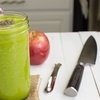Kale is the supercheap superfood that has stayed popular for so many years, and for good reason.
It's nutrient dense for its weight, and can be used in many dishes. Starting in 2014, you started seeing kale everywhere. It still remains to be a popular ingredient in juice and smoothie recipes, and it's one of our top choices to make our green smoothies.
Preparing Kale for Smoothies
Wash the leaves thoroughly, then separate the fibrous spine from the leaves before blending.
You can blend the spine, but it may add a bit of a bitter flavor to your smoothie. If this is your first time blending kale, we recommend removing it.
Isn't kale bad for you?
There was a lot of click-baitey "kale is bad for you" articles that started to pop up when it got extremely popular. It's just the nature of the internet.
We've looked into the studies ourselves, and we can only find that cruciferous vegetables could be bad for you if you have a thyroid disorder, but the amount of kale needed to cause an issue is unknown.
Be sure to do your own research if you have any concerns.
Smoothie Recipes with Kale

Apple Ginga
We created this smoothie because we wanted to enjoy a lig...

Joe Rogan's Kale S...
We could write something about how healthy this recipe is...

K.I.S.S.
It's always tempting to throw in everything you have in t...
